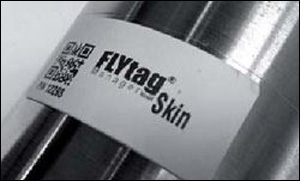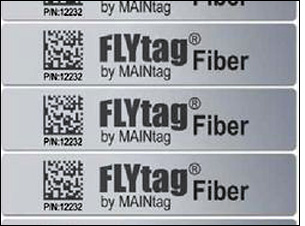MAINtag, a French RFID technology firm focused on the aerospace industry, is releasing new additions to its FLYtag line of radio frequency identification tags designed to track parts on aircraft. These new tags, the company reports, are expected to meet the requirements for monitoring the maintenance and repair of aircraft parts within non-pressurized and interior cabin locations, as well as tracking the identities and expiration dates of life vests and seats. To help it meet an expected need by aerospace companies for its RFID tags, handheld readers and software, the company also opened an American division in October 2012, located in Atlanta, Ga.
Aircraft manufacturer Airbus was an early user of MAINtag’s FLYtag and FLYtag nano tags, in 2010, as part of a pilot of RFID tags on parts for its A350 XWB aircraft, according to Alexis Beurdeley, the VP of MAINtag Americas. Since then, Airbus has announced that by next year, suppliers will be required to provide RFID tags on all life vests and seats supplied by the parts manufacturers for its new aircraft—namely, the A320, A330 and A380 models, which could amount to approximately 120,000 life vest tags and 40,000 seat tags annually (see Airbus Expands RFID Part Marking Across All of Its Aircraft Families). Additionally, MAINtag has provided more than 20,000 tags to suppliers of in-flight entertainment systems, hydraulic pumps, oxygen generators and other aircraft components.

“This is a very exciting time for us,” Beurdeley says, with the use of RFID “being activated on all sides, from aircraft manufacturers to MROs to OEMs.” In fact, there are four customer sectors for MAINtag: aircraft manufacturers, such as Airbus and other major aerospace companies throughout North and South America; maintenance, repair and operations (MRO) firms; airline operators; and parts suppliers. About 40 percent of those customers, he reports, are based in the United States, which has led to the opening of the firm’s MAINtag Americas division.
The adoption of radio frequency identification in the air-transportation industry has been slow, in part due to the need to adhere to regulations regarding the technology’s use on aircraft. RFID tags provide visibility into parts moving through the supply chain, as well as also through maintenance and inspection. However, aerospace standards must be met, in addition to unique aircraft manufacturers’ requirements. The EPC Gen 2 standard for passive ultrahigh-frequency (UHF) RFID tags has been accepted by the industry as the technology to be used worldwide for tracking aerospace parts in both pressurized and non-pressurized areas.
In addition to expanding its line of RFID tags, MAINtag has been releasing a series of other new products, including mobile and desktop readers, and a software platform known as FLYtag Manager. The company has been providing its low- and high-memory FLYtag products for Airbus and other customers since 2010. Low-memory tags, containing 1 or 2 kilobits of memory, are used to store an item’s birth record (date of manufacture) and expiration date, and cost less than the high-memory versions. As such, they are best used on lower-value items, such as life vests. They also provide longer read ranges than high-memory tags.
The high-memory FLYtag (typically featuring 4 or 8 kilobytes of memory) can store information regarding a tag’s servicing and inspection histories. Such tags are being utilized, for example, by airline companies and their MROs to store data about each service provided to an item to which a particular tag is affixed. The tag has about a 1-meter (3.3-foot) read range, and comes with a minimum of 500 bits of space known as the “ScratchPad,” where data can either be written or removed—the electronic equivalent of “sticky” notes, according to MAINtag. The FLYtag is available in both the standard size (measuring 49 millimeters by 24 millimeters by 5.7 millimeters [1.9 inches by 0.9 inch by 0.2 inch]) and the nano version (measuring 14 millimeters [0.6 inch] in diameter by 5.3 millimeters [0.2 inch] in thickness).More recently, the company introduced an aluminum bracket and aluminum name plate version for the non-adhesive mounting of its tags, as well as the FLYtag HT and nanoHT models—which, according to the company, are both lighter than the standard FLYtag model and are designed to operate in the presence of heat. FLYtag fiber, released in this quarter of 2012, is designed for life vests and plastic parts, while the FLYtag skin will be released during the first quarter of 2013, and is more lightweight and flexible to fit curved surfaces. Like the other tags in the line, the FLYtag HT, nanoHT and FLYtag skin are available in low- and high-memory versions, while the FLYtag fiber is available in low-memory form only. The HT tags are expected to be made available next month. All of MAINtag’s high-memory tags, as well as some of its low-memory models, are made with Tego‘s high-memory chip.
The company also offers its MOBIpad AT2 handheld reader (released in 2010), with a built-in camera for picture-data association, and a 2-D bar-code scanner. In March 2013, the firm will release is WAVEbox pad, for desktop reading, with built-in FLYtag Manager software; the WAVEbox print, for encoding and printing RFID tags; and the WAVEbox access, a fixed reader for installation in portals, with a read range of 4 meters to 8 meters (13 feet to 26 feet). The FLYtag MobiPACK, available now, is a kit that includes the MOBIpad handheld interrogator, as well as five standard-size FLYtag 8-kilobyte tags, five FLYtag nano 8-kilobyte tags and software to manage read data.
According to Beurdeley, MAINtag is the only RFID company that is aerospace-certified (ISO 9001 and EN/AS/JISQ 9100), and its tags have passed independent testing from Airbus, as well as from Parker Hannifin (see A Flurry of High-Memory Tags Take Flight) and Honeywell. All three of these companies, he says, are utilizing the FLYtag.
MAINtag’s North American division, Beurdeley says, is currently in discussions with Boeing and Brazil’s Embraer regarding the use of its RFID technology for parts tracking. The firm reports that it is also providing its technology, or is discussing doing so, with all major manufacturers of Airbus’ life vests, as well as makers of the aircraft seats. Airbus requires that the life vests be tagged by March, and that the seats be tagged by the end of next year.
One such company, Switlik, which manufacturers life vests for Airbus, is preparing to meet the RFID-based mandate by March 2013, says Ross Hallen, Switlik’s director of marketing and business development. EAM Worldwide, an Airbus supplier based in Florida, has already been tagging its life vests—building the tags directly into each vest—since 2009 (see RFID Finally Cleared for Takeoff). It also opened its own RFID division in 2010, which developed software to manage reads of its RFID-tagged parts before they leave the facility, explains Eloy Leal, EAM’s director of operations and engineering. The company has been utilizing tags containing 512 bits of memory, but is considering switching to tags with 1 or 2 kilobits, and is presently testing the FLYtags, among others models, for this purpose. What’s more, EAM sells its RFID-based software to other businesses in the aerospace industry, as well as within other sectors, such as fire departments looking to track assets.


